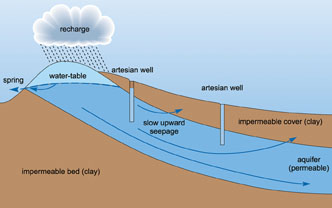Groundwater
Groundwater is water found beneath the ground surface held in the spaces within porous soil and rock. Groundwater can be obtained from springs, boreholes or wells. A borehole is a particular type of well with a narrow shaft. Usually a drilling rig is needed to drill (bore) the hole into the rock.
The depth that water is taken from and the types of rock it has passed through are important factors that affect the quality of the groundwater. Groundwater, particularly from deep sources, may provide water of good microbiological quality. This is because bacteria, protozoa, viruses and helminths are filtered from the water as it passes through the layers of soil and rock into the groundwater. Groundwater sources are therefore preferable to surface water sources. However, groundwater can contain chemical contaminants, such as arsenic, fluorides and nitrates.
Springs
Permeable rocks have tiny spaces between the solid rock particles that allow water and other fluids to pass through and be held within the rock structure. Impermeable rocks do not have these spaces and water cannot pass through them.
A spring occurs at the point where the boundary between a permeable layer of underground rock and an impermeable layer reaches the ground surface. Rainwater percolates (trickles down) through the soil into permeable layers of subsoil or underground rock. The downward percolation will be stopped if this layer sits on top of an impermeable layer and the water can go no further. Depending on the slope of the layers, the water will run along the top of the impermeable layer to a point where it reaches the surface and emerges as a spring (see Figure 15.3). A spring may vary in volume and contamination levels according to the amount of rainfall.

Springs are likely to be polluted by direct contamination through the topsoil unless the surrounding land area is protected. A spring supply issuing from a deep, water-bearing layer, rather than a permeable layer near the surface, can produce both a consistent volume and a better quality supply. Whether the spring originates from shallow or deep rock layers, animals should be excluded from the surrounding area by a stock-proof fence, and any water running off the land after rain should be diverted to a suitable ditch away from the spring.
Wells
The practice of obtaining water from wells is common and well water is an important source of supply in many developing countries like Ethiopia. A well should be located uphill from any possible sources of pollution. Wells are classified based on the depths of the water-bearing layers as follows:
- Shallow wells tap into water held in aquifers (layers of water-bearing rock) above the first impermeable layer. ‘Shallow' is not a definite depth, but an indication of the layer of rock from which it is abstracted.
- Deep wells obtain water from aquifers below at least one impermeable layer. A deep well must be constructed so as to exclude subsoil water and contamination from above. It should be watertight down to a point slightly below the level of the deep supply.
- Artesian supply. Water in aquifers is sometimes under pressure because of the surrounding impermeable layers and this can cause the water to flow upwards to the surface. In Figure 15.3, the water level in the two artesian wells is determined by the level of the water table. In the well on the right, water rises to the land surface but in the well on the left it does not.